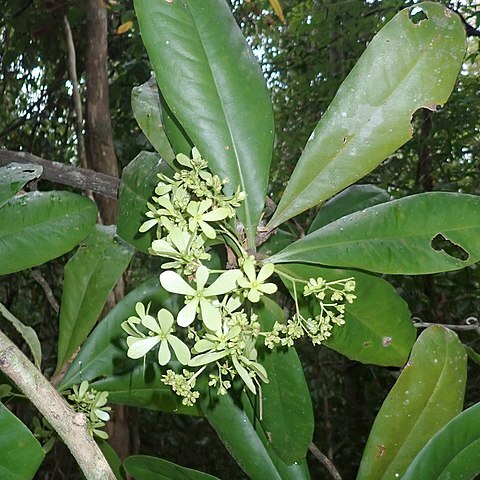Liana, in the youth and in open scrub often a shrub, later often trailing; main shoots provided with scattered ± erect small leaves, between and near which arise spreading non-foliate tendril-like shoots provided with 3-6 curved hooks, lower 2 rarely 3 hooks getting woody, hooks mostly unilateral, rarely 1-2 alternate; these 'tendrils' later woody, becoming branches, upper part vanishing. Leaves crowded mostly immediately above the 2nd hook, variable in size and shape, sessile, mostly obovate-oblong, tapering towards the base, apex obtuse, rounded, acute or even acuminate, blade 9-30 by 3-10 cm; nerves 4-8 on either side, spreading, connected by a slightly looped intramarginal vein and a 2nd feeble! outer one, rather straight, numerous secondary veins often becoming as strong as the main nerves and parallel. Inflorescences between the crowded leaves, very rarely lateral in the place of a 'tendril' on the main shoot, repeatedly dichotomous, branches divaricate, 8-15 cm long. Flowers rather crowded at their tips. Calyx lobes inequal, oval, thin-margined, glabrous except the short ciliate rounded apex, some or all lobes provided with 1-3 conspicuous crateriform prominent glands, mostly shorter than the corolla, 1¾-2½ mm long, soon enlarging. Petals oblique-oval, one margin often involute, acute, 3-3½ by 1¾ mm. Styles erect, nearly as long as the nipple-shaped ovary-top, both ½ mm high, stigma punctiform. Stamens alternately inequal; filament broadened at the base; cells free, acute, more or less latrorse. Fruit with spreading calyx wings slightly decurrent on the obconical sub-5-angular smooth tube, oblong-cune-ate to spathulate, inequal, often oblique, apex blunt to rounded, with 3 larger nerves and numerous smaller densely reticulate ones, overlapping at the base, smallest mature ones measured 2½ by ½ cm, largest 5 by 1¾ cm; nipple broad-obcampanulate, ± 3 mm high protruding, solid, not filled with part of the seed. Seed obconical with flat apex, ca 5 mm high, mostly consisting of a ruminate endosperm; germ ca 2-2½ mm high, erect, straight, obliquely inserted.
More
Juvenile plants unknown but probably erect. Adult stems climbing to 20 m high; lateral branches with recurved to spiraling hooks. Stipules tiny, mostly caducous with saddlelike scars on branches; leaves at branchlet apices elliptic to obovate, 7-38(-50.2) × 2.1-9.3(-11.7) cm, leathery, both surfaces frequently with small, white, orbicular pits, base attenuate and decurrent, apex rounded or rounded-obtuse, rarely acute; midvein prominent abaxially, impressed adaxially, lateral and reticulate tertiary veins tenuous, slightly prominent on both surfaces. Inflorescence lax to congested, paniculate, lateral among leaves at apices of branches; bracts triangular to ovate, 0.2-2.4 × 0.2-1.5 mm, abaxially eglandular or with 1 or 2 circular glands, margin fimbriate-erose, apex acute. Pedicel 0.3-3 mm. Sepals 5, at base shortly decurrent on ovary, suborbicular to elliptic-oblong, slightly unequal, 3.2-5.5 mm, outside eglandular or with 1-4 shallowly cupular glands below middle, inside with white orbicular small pits near base, apex rounded. Petals 5, convolute, connate basally, suborbicular to obliquely elliptic, 5-6 mm, apex acute, usually involute. Stamens in 1 whorl, 5 longer than others; filaments wider basally, dimorphic: shorter ones 0.3-1.2 mm, longer ones 1.1-2 mm. Ovary fully inferior; styles 3, erect, ca. 1 mm; stigmas ca. 0.2 mm. Nut red, obconic, sides 5-ridged by decurrent margins of accrescent sepals, 5-9 mm, 5-10 mm in diam.; persistent sepals spreading, narrowly oblong to spatulate, unequal, larger 3 sepals 3-5.6 × 1-1.7(-2.5) cm, smaller 2 sepals 2-3(-4) × 0.5-1.2(-1.9) cm, veined, apex rounded. Seeds subglobose. Fl. Apr-Jun, fr. Jun [fl. and fr. year-round outside of China].
A woody climber. It has a tough stem. The stems can be 20 m long. The side branches have hooks. The leaves are narrowly oval and 7-38 cm long by 2-9 cm wide.
Evergreen tropical forests in valleys and on slopes from sea level to 1,600 metres. Low elevations, often near the sea, sometimes on the margin of the beach, mostly on siliceous soils, both in mixed forest and padang scrub.
More
Low altitude, often near the sea, sometimes on the margin of the beach, mostly on silicious soils, both in mixed forest and padang scrub fr. fl. March-Aug.
A tropical plant. It grows on sandy soil. It grows near the sea.

